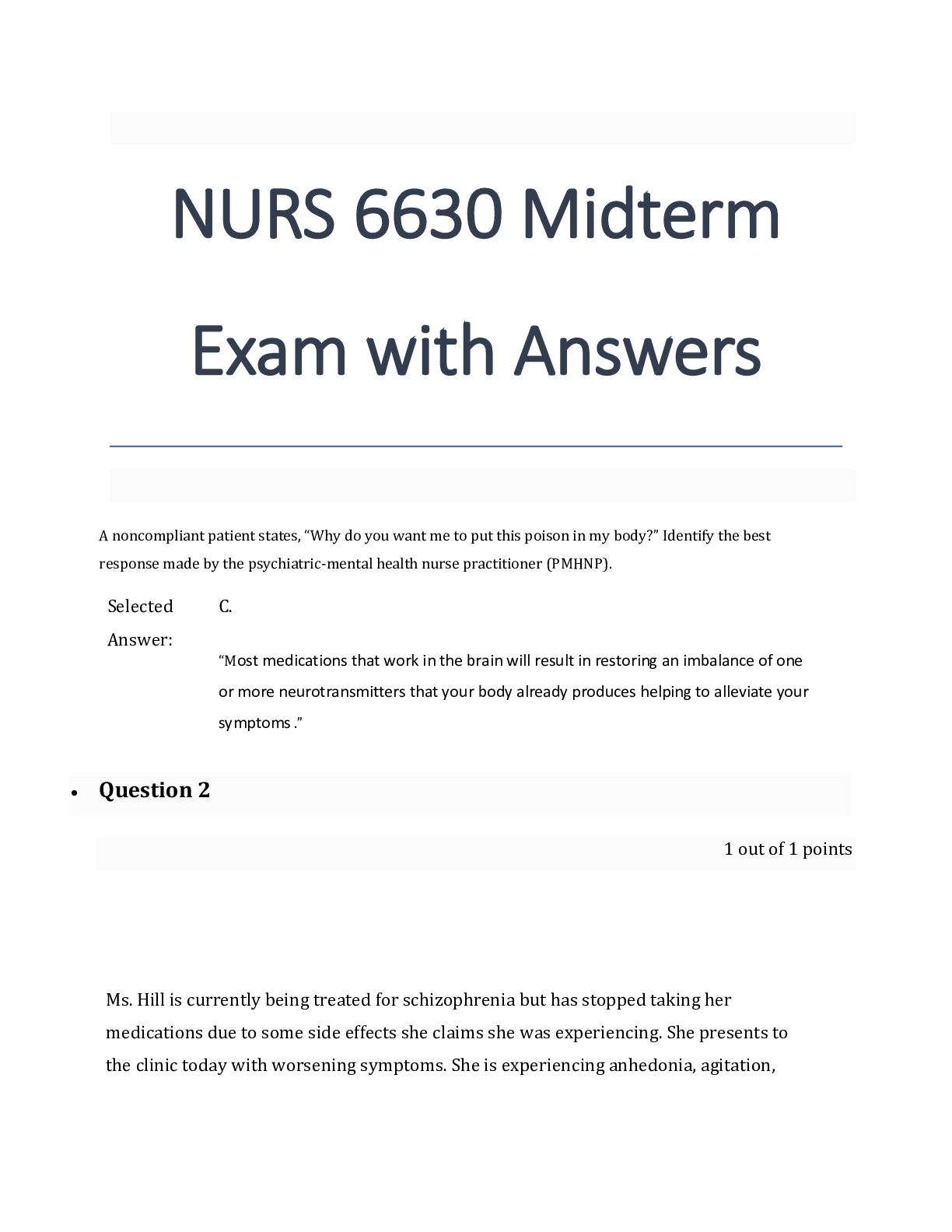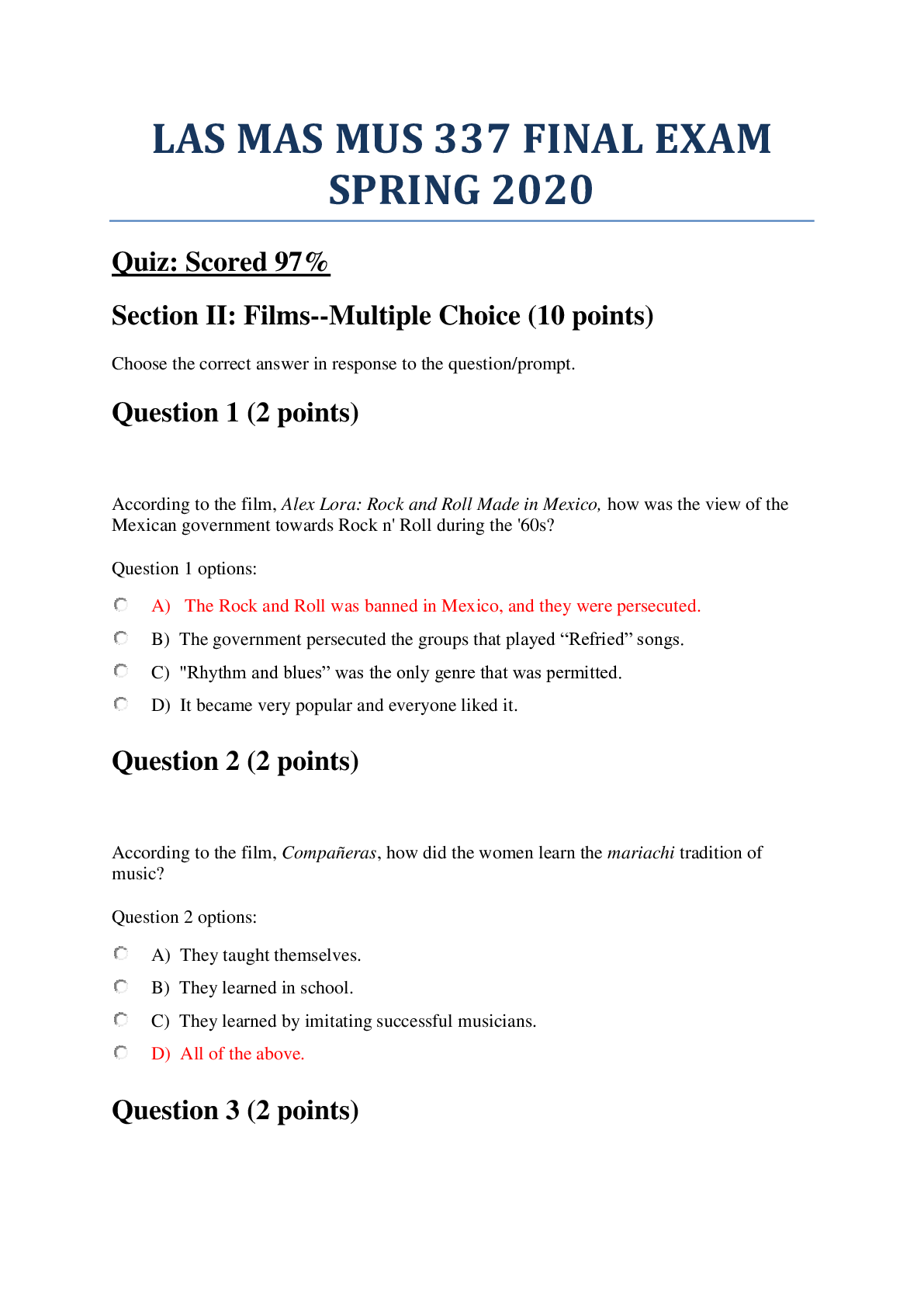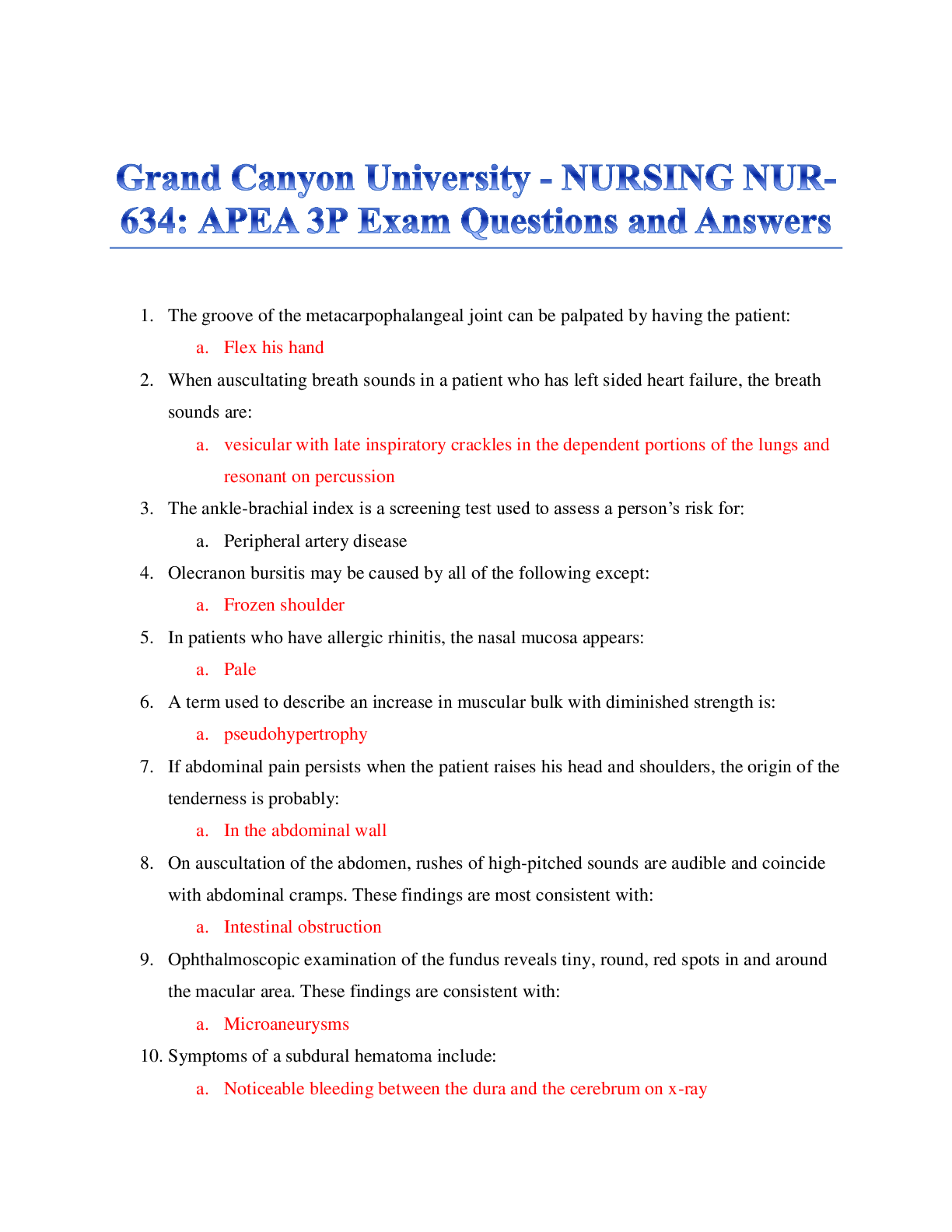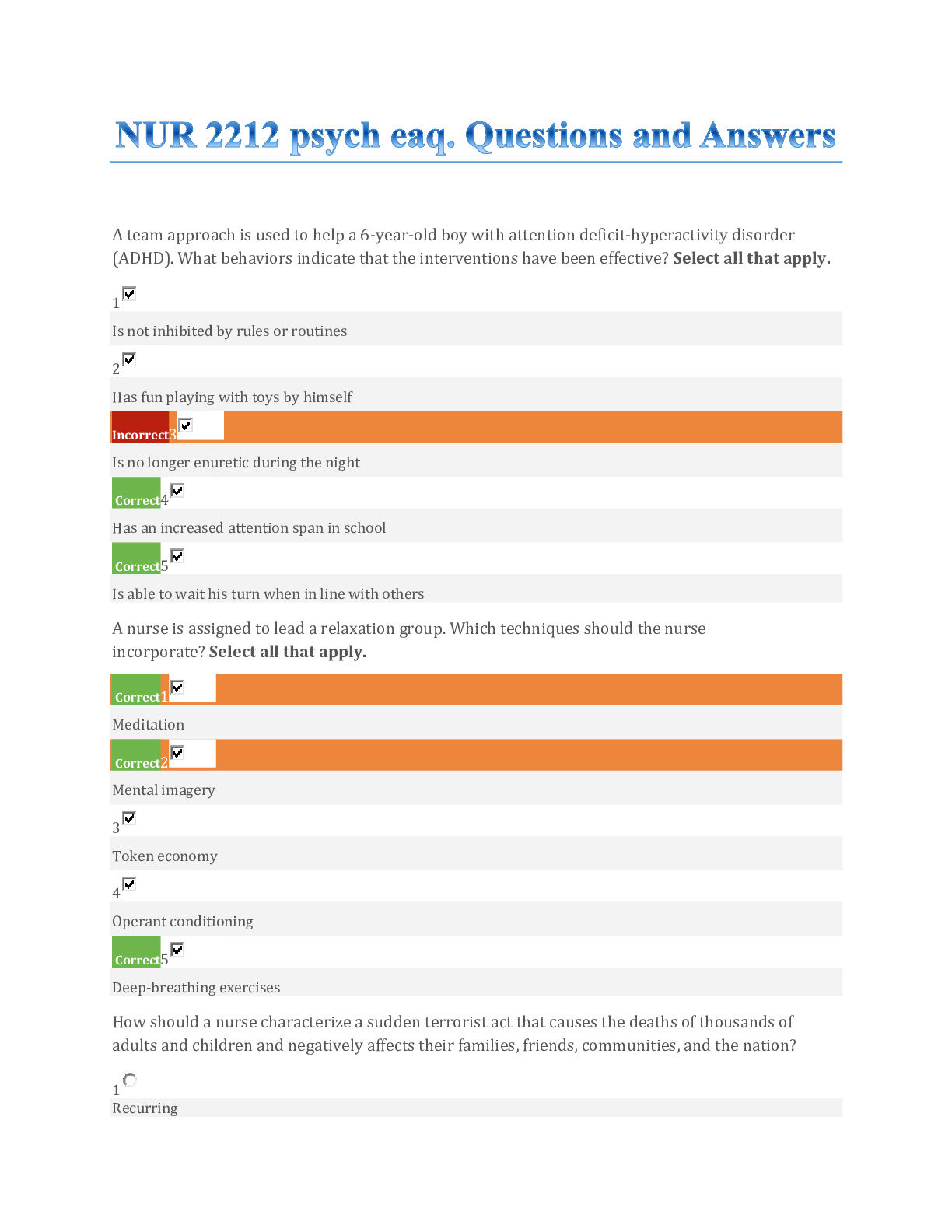Economics > EXAM > University of Texas, El Paso ECON 3310 CHAPTER 17. 40 Questions and Answers (All)
University of Texas, El Paso ECON 3310 CHAPTER 17. 40 Questions and Answers
Document Content and Description Below
CHAPTER 17 1) When a variable can take on different values a) it is a random variable b) it is a dependent variable c) it is an independent variable d) it is an exogenous variable 2) The expec... ted value is a) the product of the sums of the probability and the values in different states b) the sum of the products of the probability and the values in different states c) the difference between the products of the probability and the values in different states d) the difference between the sums of the probability and the values in different states 3) Heads and tails are equally likely but you win a dollar on heads and lose a dollar on tails a) the expected value is $0.50 b) the expected value is -$0.50 c) the expected value is $1.00 d) the expected value is $0.00 4) Heads and tails are equally likely but you win $2.00 on heads and lose $1.00 on tails a) the expected value is $0.50 b) the expected value is -$0.50 c) the expected value is $1.00 d) the expected value is $0.00 5) Heads and tails are equally likely but you win $3.00 on heads and lose $1.00 on tails a) the expected value is $0.50 b) the expected value is -$0.50 c) the expected value is $1.00 d) the expected value is $0.00 6) You can invest $100,000 into either project A or B. You estimate that A succeeds with probability 0.7 in which case it doubles in value. If it fails, the scrap value is worth $50,000. Project B succeeds with probability 0.6, has value $150,000 if it succeeds and value of $30,000 if not. a) You should invest in project A b) You should invest in project B c) You should not invest in either d) You cannot tell from the information presented 7) You can invest $100,000 into either project A or B. You estimate that A succeeds with probability 0.6 in which case it doubles in value. If it fails, the scrap value is worth $50,000. Project B succeeds with probability 0.7, has value $150,000 if it succeeds and value of $30,000 if not. a) You should invest in project A b) You should invest in project B c) You should not invest in either d) You cannot tell from the information presented 8) You can invest $100,000 into either project A or B. You estimate that A succeeds with probability 0.5 in which case it doubles in value. If it fails, the scrap value is worth $50,000. Project B succeeds with probability 0.8, has value $150,000 if it succeeds and value of $30,000 if not. a) You should invest in project A b) You should invest in project B c) You should not invest in either d) You cannot tell from the information presented 9) You can invest in either project A or B. Project A has value $100 with probability 0.1 and value $75 with probability 0.9. Project B has value $110 with probability 0.2 and value $70 with probability 0.8. a) You should invest in project A b) You should invest in project B c) You should not invest in either d) You cannot tell from the information presented 10) You can invest in either project A or B. Project A has value $150 with probability 0.1 and value $75 with probability 0.9. Project B has value $120 with probability 0.2 and value $75 with probability 0.8. a) You should invest in project A b) You should invest in project B c) You should not invest in either d) You cannot tell from the information presented 11) You can invest in either project A or B. Project A has value $150 with probability 0.1 and value $75 with probability 0.9. Project B has value $110 with probability 0.2 and value $65 with probability 0.8. a) You should invest in project A b) You should invest in project B c) You should not invest in either d) You cannot tell from the information presented 12) You can invest in either project A or B. Project A has value $150 with probability 0.1 and value $75 with probability 0.9. Project B has value $110 with probability 0.2 and value $65 with probability 0.8. a) You should invest in project A b) You should invest in project B c) You should not invest in either d) You cannot tell from the information presented A 13) Three possibilities are equally likely and have payoffs of $3, $6, and $9. The expected value is: a) $4 b) $5 c) $6 d) $7 14) Four possibilities are equally likely and have payoffs of $2, $4, $6, and $8. The expected value is: a) $4 b) $5 c) $6 d) $7 15) Five possibilities are equally likely and have payoffs of $2, $4, $6, $8, and $10. The expected value is: a) $4 b) $5 c) $6 d) $7 16) Six possibilities are equally likely and have payoffs of $2, $4, $6, $8, $10, and $12. The expected value is: a) $4 b) $5 c) $6 d) $7 17) Three possibilities have probabilities 0.5, 0.3 and 0.2 and values $10, $20, and $30 respectively. The expected value is: a) $15 b) $16 c) $17 d) $18 18) Three possibilities have probabilities 0.4, 0.4 and 0.2 and values $10, $20, and $30 respectively. The expected value is: a) $15 b) $16 c) $17 d) $18 19) Three possibilities have probabilities 0.5, 0.4 and 0.1 and values $10, $20, and $30 respectively. The expected value is: a) $15 b) $16 c) $17 d) $18 20) Four possibilities have probabilities 0.4, 0.2, 0.2 and 0.2 and values $10, $20, $30, and $40 respectively. The expected value is: a) $22 b) $24 c) $26 d) $28 21) Four possibilities have probabilities 0.4, 0.2, 0.2 and 0.2 and values $20, $20, $40, and $40 respectively. The expected value is: a) $22 b) $24 c) $26 d) $28 22) Four possibilities have probabilities 0.4, 0.2, 0.2 and 0.2 and values $40, $30, $20, and $10 respectively. The expected value is: a) $22 b) $24 c) $26 d) $28 23) Four possibilities have probabilities 0.4, 0.2, 0.2 and 0.2 and values $80, $30, $0, and -$80 respectively. The expected value is: a) $22 b) $24 c) $26 d) $28 24) Half of all potential customers would pay $10 for your product but half would only pay $8 but you cannot tell them apart. Your marginal costs are $4. If you set the price at $10, the expected profit is: a) $3 b) $4 c) $5 d) $6 25) Half of all potential customers would pay $10 for your product but half would only pay $8 but you cannot tell them apart. Your marginal costs are $4. If you set the price at $8, the expected profit is: a) $3 b) $4 c) $5 d) $6 26) Half of all potential customers would pay $16 for your product but half would only pay $10 but you cannot tell them apart. Your marginal costs are $4. If you set the price at $16, the expected profit is: a) $3 b) $4 c) $5 d) $6 27) Half of all potential customers would pay $16 for your product but half would only pay $10 but you cannot tell them apart. Your marginal costs are $4. If you set the price at $10, the expected profit is: a) $3 b) $4 c) $5 d) $6 28) You raise your product price by $10 in market A but leave it unchanged in market B. Sales in A fall from 840 units per week to 740 while sales in B rise from 770 to 790. The Difference-in-difference estimate of the effect of the price change is: a) 80 units b) 100 units c) 120 units d) 140 units 29) You experiment by offering free warranties for your product in market A not in market B. Sales in A rise from 240 units per week to 360 while sales in B rise from 410 to 430. The Difference-in-difference estimate of the effect of the free warranty is: a) 80 units b) 100 units c) 120 units d) 140 units 30) You increase your advertising buy for your product in market A but not in market B. Sales in A rise from 1140 units per week to 1180 while sales in B fall from 1270 to 1230. The Difference-in-difference estimate of the effect of the increased advertising is: a) 80 units b) 100 units c) 120 units d) 140 units 31) You put your product on 20% off sale market A but leave it unchanged in market B. Sales in A increase from 840 units per week to 1040 while sales in B rise from 770 to 830. The Difference-in-difference estimate of the effect of the price change is: a) 80 units b) 100 units c) 120 units d) 140 units 32) You want to run a difference-in-difference experiment with a price increase for your lawn chairs in Miami. If you are worried about the "representativeness" of your control group, a good comparison city would be a) Boston b) San Francisco c) St. Paul d) Tampa Bay 33) You want to run a difference-in-difference experiment with a price increase for your lawn chairs in Miami. If you are worried about "leakage" with your control group, a poor comparison city would be a) Boston b) San Francisco c) St. Paul d) Tampa Bay 34) You want to run a difference-in-difference experiment with a price increase for the bacon cheeseburger item on your menu. If you are worried about "leakage" with your control group, a good comparison menu item would be a) soft drink sales b) the bacon burger without cheese c) the bacon-lettuce-and-tomato sandwich d) the regular cheeseburger 35) You want to run a difference-in-difference experiment with a price increase for the bacon cheeseburger item on your menu. If you are worried about the "representativeness" with your control group, a poor comparison menu item would be a) soft drink sales b) the bacon burger without cheese c) the bacon-lettuce-and-tomato sandwich d) the regular cheeseburger 36) A movie executive has to decide to fund a new movie project. For this project, a success would earn $20 million and a failure would cost $60 in lost profits. At what probability of expected success should he fund the movie? a) 0.20 b) 0.25 c) 0.50 d) 0.75 37) A pharmaceutical company executive has to decide whether to fund a new drug development project. For this project, a success would earn $10 million and a failure would cost $90 in lost profits. At what probability of expected success should she fund the project? a) 0.10 b) 0.20 c) 0.80 d) 0.90 38) A "false positive" is a) when you incorrectly conclude that your hypothesis is true b) when you incorrectly conclude that your hypothesis is false c) when you correctly conclude that your hypothesis is true d) when you correctly conclude that your hypothesis is false 39) A "false negative" is a) when you incorrectly conclude that your hypothesis is true b) when you incorrectly conclude that your hypothesis is false c) when you correctly conclude that your hypothesis is true d) when you correctly conclude that your hypothesis is false 40) We worry that false negatives occur too often relative to false positives due to a) most hypotheses being false b) it being appropriate to set a high standard for acceptance of a hypothesis c) managers having an incentive to make a false negative conclusion because they are harder for superiors to observe d) they are not too common 41) A manager may over-research the appropriateness of a decision a) because the costs of a false positive are usually larger b) because the costs of a false negative are usually larger c) because it is important to be 100% certain before making a decision d) because managers can face inordinate censure from agreeing to a bad decision 42) Which types of poor decisions are more visible to a decision maker's supervisor? a) agreeing to undertake a project b) deciding not to undertake a project c) deciding to investigate a proposed project until one is certain d) deciding to randomly choose whether to undertake the project 43) The key distinction between risk and uncertainty is a) risk cannot be quantified, priced or traded b) uncertainty refers to not knowing possible outcomes or their probabilities c) uncertainty is modeled by listing the possible outcomes and assigning probabilities to the outcomes d) risk has to do with not knowing the probability distribution of a random variable [Show More]
Last updated: 2 years ago
Preview 1 out of 8 pages

Buy this document to get the full access instantly
Instant Download Access after purchase
Buy NowInstant download
We Accept:

Reviews( 0 )
$9.00
Can't find what you want? Try our AI powered Search
Document information
Connected school, study & course
About the document
Uploaded On
Apr 15, 2022
Number of pages
8
Written in
Additional information
This document has been written for:
Uploaded
Apr 15, 2022
Downloads
0
Views
77














